Irena Gao
Model Equality Testing: Which Model Is This API Serving?
Oct 26, 2024Abstract:Users often interact with large language models through black-box inference APIs, both for closed- and open-weight models (e.g., Llama models are popularly accessed via Amazon Bedrock and Azure AI Studio). In order to cut costs or add functionality, API providers may quantize, watermark, or finetune the underlying model, changing the output distribution -- often without notifying users. We formalize detecting such distortions as Model Equality Testing, a two-sample testing problem, where the user collects samples from the API and a reference distribution and conducts a statistical test to see if the two distributions are the same. We find that tests based on the Maximum Mean Discrepancy between distributions are powerful for this task: a test built on a simple string kernel achieves a median of 77.4% power against a range of distortions, using an average of just 10 samples per prompt. We then apply this test to commercial inference APIs for four Llama models, finding that 11 out of 31 endpoints serve different distributions than reference weights released by Meta.
OpenFlamingo: An Open-Source Framework for Training Large Autoregressive Vision-Language Models
Aug 07, 2023



Abstract:We introduce OpenFlamingo, a family of autoregressive vision-language models ranging from 3B to 9B parameters. OpenFlamingo is an ongoing effort to produce an open-source replication of DeepMind's Flamingo models. On seven vision-language datasets, OpenFlamingo models average between 80 - 89% of corresponding Flamingo performance. This technical report describes our models, training data, hyperparameters, and evaluation suite. We share our models and code at https://github.com/mlfoundations/open_flamingo.
Are aligned neural networks adversarially aligned?
Jun 26, 2023



Abstract:Large language models are now tuned to align with the goals of their creators, namely to be "helpful and harmless." These models should respond helpfully to user questions, but refuse to answer requests that could cause harm. However, adversarial users can construct inputs which circumvent attempts at alignment. In this work, we study to what extent these models remain aligned, even when interacting with an adversarial user who constructs worst-case inputs (adversarial examples). These inputs are designed to cause the model to emit harmful content that would otherwise be prohibited. We show that existing NLP-based optimization attacks are insufficiently powerful to reliably attack aligned text models: even when current NLP-based attacks fail, we can find adversarial inputs with brute force. As a result, the failure of current attacks should not be seen as proof that aligned text models remain aligned under adversarial inputs. However the recent trend in large-scale ML models is multimodal models that allow users to provide images that influence the text that is generated. We show these models can be easily attacked, i.e., induced to perform arbitrary un-aligned behavior through adversarial perturbation of the input image. We conjecture that improved NLP attacks may demonstrate this same level of adversarial control over text-only models.
Out-of-Domain Robustness via Targeted Augmentations
Feb 23, 2023Abstract:Models trained on one set of domains often suffer performance drops on unseen domains, e.g., when wildlife monitoring models are deployed in new camera locations. In this work, we study principles for designing data augmentations for out-of-domain (OOD) generalization. In particular, we focus on real-world scenarios in which some domain-dependent features are robust, i.e., some features that vary across domains are predictive OOD. For example, in the wildlife monitoring application above, image backgrounds vary across camera locations but indicate habitat type, which helps predict the species of photographed animals. Motivated by theoretical analysis on a linear setting, we propose targeted augmentations, which selectively randomize spurious domain-dependent features while preserving robust ones. We prove that targeted augmentations improve OOD performance, allowing models to generalize better with fewer domains. In contrast, existing approaches such as generic augmentations, which fail to randomize domain-dependent features, and domain-invariant augmentations, which randomize all domain-dependent features, both perform poorly OOD. In experiments on three real-world datasets, we show that targeted augmentations set new states-of-the-art for OOD performance by 3.2-15.2%.
CREPE: Can Vision-Language Foundation Models Reason Compositionally?
Dec 13, 2022Abstract:A fundamental characteristic common to both human vision and natural language is their compositional nature. Yet, despite the performance gains contributed by large vision and language pretraining, we find that - across 6 architectures trained with 4 algorithms on massive datasets - they exhibit little compositionality. To arrive at this conclusion, we introduce a new compositionality evaluation benchmark CREPE which measures two important aspects of compositionality identified by cognitive science literature: systematicity and productivity. To measure systematicity, CREPE consists of three test datasets. The three test sets are designed to test models trained on three of the popular training datasets: CC-12M, YFCC-15M, and LAION-400M. They contain 385K, 385K, and 373K image-text pairs and 237K, 210K, and 178K hard negative captions. To test productivity, CREPE contains 17K image-text pairs with nine different complexities plus 246K hard negative captions with atomic, swapping, and negation foils. The datasets are generated by repurposing the Visual Genome scene graphs and region descriptions and applying handcrafted templates and GPT-3. For systematicity, we find that model performance decreases consistently when novel compositions dominate the retrieval set, with Recall@1 dropping by up to 8%. For productivity, models' retrieval success decays as complexity increases, frequently nearing random chance at high complexity. These results hold regardless of model and training dataset size.
Adaptive Testing of Computer Vision Models
Dec 06, 2022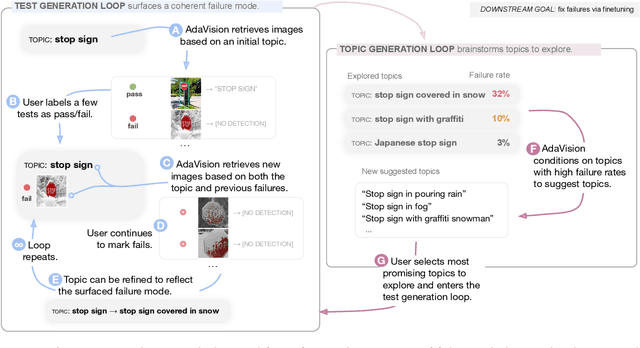
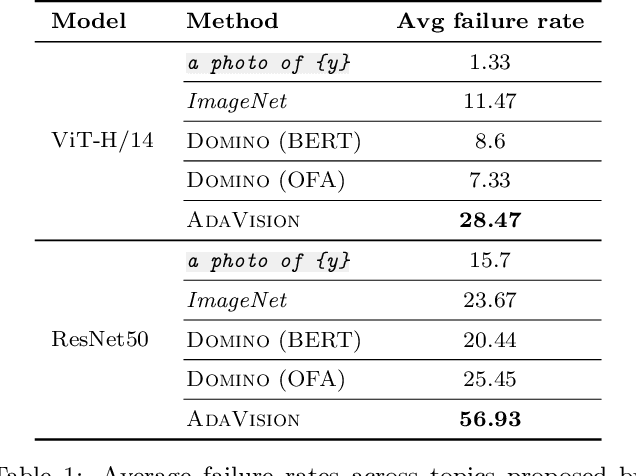
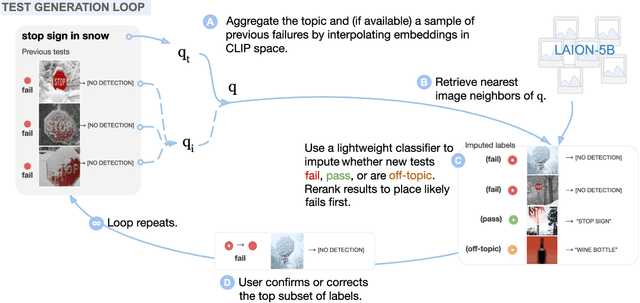

Abstract:Vision models often fail systematically on groups of data that share common semantic characteristics (e.g., rare objects or unusual scenes), but identifying these failure modes is a challenge. We introduce AdaVision, an interactive process for testing vision models which helps users identify and fix coherent failure modes. Given a natural language description of a coherent group, AdaVision retrieves relevant images from LAION-5B with CLIP. The user then labels a small amount of data for model correctness, which is used in successive retrieval rounds to hill-climb towards high-error regions, refining the group definition. Once a group is saturated, AdaVision uses GPT-3 to suggest new group descriptions for the user to explore. We demonstrate the usefulness and generality of AdaVision in user studies, where users find major bugs in state-of-the-art classification, object detection, and image captioning models. These user-discovered groups have failure rates 2-3x higher than those surfaced by automatic error clustering methods. Finally, finetuning on examples found with AdaVision fixes the discovered bugs when evaluated on unseen examples, without degrading in-distribution accuracy, and while also improving performance on out-of-distribution datasets.
Extending the WILDS Benchmark for Unsupervised Adaptation
Dec 09, 2021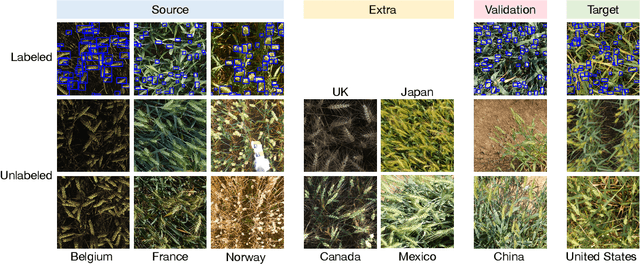

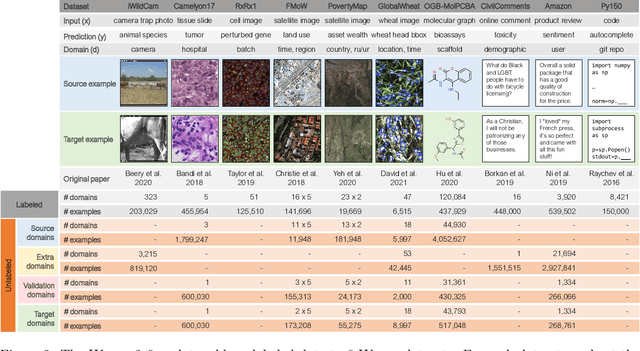
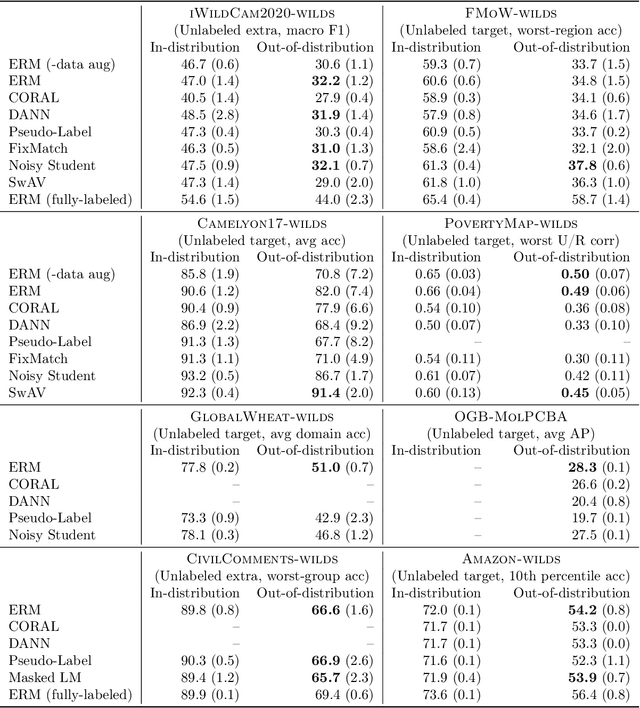
Abstract:Machine learning systems deployed in the wild are often trained on a source distribution but deployed on a different target distribution. Unlabeled data can be a powerful point of leverage for mitigating these distribution shifts, as it is frequently much more available than labeled data. However, existing distribution shift benchmarks for unlabeled data do not reflect the breadth of scenarios that arise in real-world applications. In this work, we present the WILDS 2.0 update, which extends 8 of the 10 datasets in the WILDS benchmark of distribution shifts to include curated unlabeled data that would be realistically obtainable in deployment. To maintain consistency, the labeled training, validation, and test sets, as well as the evaluation metrics, are exactly the same as in the original WILDS benchmark. These datasets span a wide range of applications (from histology to wildlife conservation), tasks (classification, regression, and detection), and modalities (photos, satellite images, microscope slides, text, molecular graphs). We systematically benchmark state-of-the-art methods that leverage unlabeled data, including domain-invariant, self-training, and self-supervised methods, and show that their success on WILDS 2.0 is limited. To facilitate method development and evaluation, we provide an open-source package that automates data loading and contains all of the model architectures and methods used in this paper. Code and leaderboards are available at https://wilds.stanford.edu.
 Add to Chrome
Add to Chrome Add to Firefox
Add to Firefox Add to Edge
Add to Edge